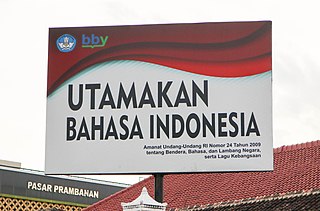Related Research Articles
The Schouten languages are a linkage of Austronesian languages in northern Papua New Guinea. They are in contact with various North Papuan languages, particularly the Skou and some Torricelli languages.
The Senagi languages are a small family of Papuan languages in the classification of Malcolm Ross, that had been part of Stephen Wurm's Trans–New Guinea proposal. They consist of the two languages Angor and Dera.
The Ata language, also known as Pele-Ata after its two dialects, or Wasi, is a Papuan language spoken on New Britain island, Papua New Guinea. It appears to be related to neighboring Anêm, and possibly also to Yélî Dnye in a proposed Yele-West New Britain family. There are about 2000 speakers.
Lungalunga, frequently though ambiguously called Minigir, is spoken by a small number of the Tolai people of Papua New Guinea, who live on the Gazelle Peninsula in East New Britain Province. It is often referred to in the linguistics literature as the Tolai "dialect" with an.

More than 700 living languages are spoken in Indonesia. This figure indicates that Indonesia has about 10% of the world's languages, establishing its reputation as the second most linguistically diverse nation in the world after Papua New Guinea. Most languages belong to the Austronesian language family, while there are over 270 Papuan languages spoken in eastern Indonesia. The language most widely spoken as a native language is Javanese.
Duwet, also known as Guwot or Waing, is an aberrant member of the Busu subgroup of Lower Markham languages in Morobe Province, Papua New Guinea. Duwet is spoken by about 400 people and appears to have been heavily influenced by its neighboring Nabak language of the Papuan Trans–New Guinea languages. It is spoken in the three villages of Lambaip, Lawasumbileng, and Ninggiet.

Papua New Guinea, a sovereign state in Oceania, is the most linguistically diverse country in the world. According to Ethnologue, there are 840 living languages spoken in the country. In 2006, Papua New Guinea Prime Minister Sir Michael Somare stated that "Papua New Guinea has 832 living languages ."

The Kainantu–Goroka languages are a family of Papuan languages established by Arthur Capell in 1948 under the name East Highlands. They formed the core of Stephen Wurm's 1960 East New Guinea Highlands family, and are one of the larger branches of Trans–New Guinea in the 2005 classification of Malcolm Ross.
Dusner is a language spoken in the village of Dusner in the province of West Papua, Indonesia. Dusner is highly endangered, and has been reported to have just three remaining speakers.
Kayagar is a Papuan language spoken in South Papua. Wiyagar is spoken in Sigare Village, Kaitok Village and Yame Village in Assue District, Mappi Regency, While Kaigar is spoken in Amagais Village, Der Koumur District, Asmat Regency.
Waropen is an Austronesian language spoken at the Geelvink Bay of Indonesian Papua. It is fairly closely related to the Yapen languages. Dialects are Waropen Kai, Napan, and Ambumi.
The Tiang language, also known as Djaul, is a language spoken in Papua New Guinea.
Mandobo, or Kaeti, is a Papuan language of Mandobo District in Boven Digoel Regency, South Papua, Indonesia.
Biga is a heavily Papuan-influenced Austronesian language spoken in Southwest Papua, Indonesia in the south of the island of Misool. It is spoken in the single village of Biga in Misol Timur Selatan District.
Ambel (Amber), also known as Waigeo after the island where it is primarily spoken, is a heavily Papuan-influenced Austronesian language spoken on the island of Waigeo in the Raja Ampat archipelago near the northwestern tip of West Papua, Indonesia. It is spoken by approximately 1,600 people. It is endangered, as the population is shifting to Papuan Malay and few people born after the year 2000 have any knowledge of the language.
Yakamul, also known as Kap or Ali, is an Austronesian language spoken in East Aitape Rural LLG, Sandaun Province, Papua New Guinea. It is spoken in the village of Yakamul on the north coast and on the islands of Ali, Angel, and Seleo islands.
Gumawana is an Austronesian language spoken by people living on the Amphlett Islands of the Milne Bay Province of Papua New Guinea.
Terebu (Turubu) is one of three Kairiru languages spoken in East Sepik Province, Papua New Guinea. It is spoken in Turubu village of Turubu Rural LLG, East Sepik Province.
Mwatebu is an Austronesian language spoken in a single village in the D'Entrecasteaux Islands of Papua New Guinea. It is spoken in the single village of Mwatebu in Duau Rural LLG, Milne Bay Province.
Lenkau is an Oceanic language spoken in a single village on Rambutyo Island in Manus Province, Papua New Guinea. It is spoken in Lenkau village, Rapatona Rural LLG.
References
- ↑ Yaweyuha at Ethnologue (18th ed., 2015) (subscription required)